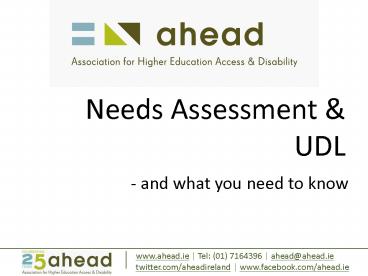Needs Assessment - PowerPoint PPT Presentation
1 / 25
Title:
Needs Assessment
Description:
Needs Assessment & UDL - and what you need to know Today What is it? Why and how a needs assessment works What needs to be considered The assessor, their role? – PowerPoint PPT presentation
Number of Views:475
Avg rating:3.0/5.0
Title: Needs Assessment
1
Needs Assessment UDL
- and what you need to know
2
Today
- What is it?
- Why and how a needs assessment works
- What needs to be considered
- The assessor, their role?
- When and where
3
There ain't nothin' worse than being stuck. ?
Butch, in Living in the State of Stuck
4
What success looks like
- http//youtu.be/Kg2wcklkDBY
5
Needs Assessment
- What is it?
- A systematic process for the collection of
information upon which to base an accurate
description of abilities, strengths and support
requirements of an individual - It is about becoming unstuck
6
Needs Assessment? Why?
- Because its a Systematic process!
- Matching students to all essential aspects of the
course - Identifies potential gaps in performance
- Psychological reports, OT speech and language
assessments - Identifies accommodations/supports required
- Forms basis for planning ahead
- Fulfills legal obligations
7
Assessment of Need
8
How does a Needs Assessment Work?
- 3 Main Elements
- Program of Study content
- Needs identification
- using relevent professional reports
- Statement of needs report
9
1. Analysing what needs to be done
- Review course content
- Actual skills required
- Communication skills
- Cognitive Skills
- Physical Demands
- Environment
- Other Influencing factors
- Fatigue
- Memory
10
2. Needs Identification
- Identify any gaps
- Any difficulties being experienced
- Effect of these difficulties
- What specific accommodations are required
- What strategies have worked in the past
- What resources are available
11
3. Statement of Needs Report
- Candidate details
- Contact details
- Considerations when contacting them eg texting
- Assessment of impact of disability against course
elements summary
12
Report
- Recommendations
- This can be a separate sheet for the students use
- This is what most people are interested in
- The what I need to know
- Considerations around recomendations
- Contract for recording devices
- Principles for using technological aids
- Review as it is a continuous process
13
Report
- Confidential
- Shared with those who needs to know as agreed
with student - Responsability for this can lie with student
- Consultative
- involves and includes the student
14
Report
- Facts not opinions in a Standarised format
- Challenging for professional areas
- Fact versus conjecture
- Fact Belgium hold the most Tour de France
victories of any country except France - Conjecture Belgium will wear the yellow jersey
this year!
15
Report
- Individualised
- Each students is different
- The impact of dyslexia for one student is
different to another - Accurate
- A snapshot in time may need to be revisited
- Student agrees with it
- Professional (non-therapeutic relationship)
16
From a students point of view
- http//youtu.be/g6myoXl0aQc
17
Examples of Accomodations
- Allowing note-taking at meetings
- Verbal instructions where there is difficulty
following written instructions - Consider how someone needs to get from place to
place - Assistive technology can raise standard of
performance - Gives greater freedom and independence
- Enables person to compete on an even footing
18
- Cases studies
19
Universal Design For Learning
- An outgrowth of the UD model, Universal Design
for Learning (UDL) uses UD principles, to design
courses - to be usable by all people, to the greatest
- extent possible, without the need for adaptation
- or specialized design.
20
Universal Design
Accommodation Approach
- The system/environment is designed, to
thegreatest extent possible, to be usable by all - Proactive Access
- Inclusive
- Access, as part of the environmental design,
issustainable
- Access is achieved through accommodations
and/orretrofitting existing requirements - Retroactive Access
- Special treatment
- Access must be reconsidered each time i.e. is
consumable
21
Disability Services
Old
New
- Disability Support Services Problems
- The terms support and services are more
medical model terms. - Imply that students with disabilities need
support - Keep the focus on the student as the problem
rather than the focus on the environmental
barriers.
- Disability Resource Center
- a resource to students and to the campus
community - provide services to both. - Assist the campus community in creating more
usable and inclusive environments.. - Disability as an aspect of diversity that is
integral to the community of learners
22
Who is the assessor?
- A Professional Filter
- A counsellor for staff and students and
employers - A listener
- A communicator
- Somebody who tells students
- You can win all you need is khud ye kapeen
23
(No Transcript)
24
A thought....
- The problem is not how to wipe out all
differences, but how to unite with all
differences intact - - RabindraNath Tagore
25
References
- www.ahead.ie
- NC State University http//www.ncsu.edu/dso/genera
l/universal-design.html - University of Arkanas, Little Rock
- http//www.ualr.edu/pace/index.php/shift/































